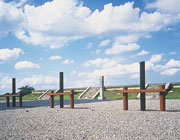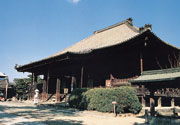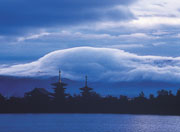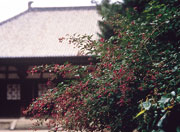 |
 |
| The ancient capital
of Japan in the 8th century |
|
 |
 For
74 years starting from 710 A.D., the capital of Japan was
Nara Heijokyo. Heijo Palace, situated at the center of the
capital was a gigantic palace extending 1.3km east to west
and 1km north to south, occupying a total area of 120ha. Recently,
"Suzakumon," the main gate of the Capital and "Toin Teien"
garden have been reconstructed. The Nara Palace Site Museum
displays pictures of the excavations of Heijo Palace, and
models of the old buildings. For
74 years starting from 710 A.D., the capital of Japan was
Nara Heijokyo. Heijo Palace, situated at the center of the
capital was a gigantic palace extending 1.3km east to west
and 1km north to south, occupying a total area of 120ha. Recently,
"Suzakumon," the main gate of the Capital and "Toin Teien"
garden have been reconstructed. The Nara Palace Site Museum
displays pictures of the excavations of Heijo Palace, and
models of the old buildings.
 0742-34-3931
(The Nara National Cultural Properties Research Institute)
/ 9:00 - 16:00 / Closed on Mondays (The Nara Palace Site Museum
and the Excavation Site Exhibition Hall) 0742-34-3931
(The Nara National Cultural Properties Research Institute)
/ 9:00 - 16:00 / Closed on Mondays (The Nara Palace Site Museum
and the Excavation Site Exhibition Hall)
 Admission
Free Admission
Free
 Take
bus No. 12 or 140 from JR or Kintetsu Nara Station and get
off at Heijokyuseki. Take
bus No. 12 or 140 from JR or Kintetsu Nara Station and get
off at Heijokyuseki. |
 |
| Try powdered green
tea served in an oversized bowl |
|
 |
 Established
in 765 A.D., Saidaiji Temple literally means the Great Western
Temple of Nara Heijokyo, then the Capital. "Ochamori" is a
popular but unique and casual tea ceremony practiced at Saidaiji
Temple. Visitors are served powdered green tea in an extra
large tea bowl more than 50cm in diameter. The bowl of course
is too large to taste from without the help of your neighbors
and the sight will bring a laugh for everyone. Established
in 765 A.D., Saidaiji Temple literally means the Great Western
Temple of Nara Heijokyo, then the Capital. "Ochamori" is a
popular but unique and casual tea ceremony practiced at Saidaiji
Temple. Visitors are served powdered green tea in an extra
large tea bowl more than 50cm in diameter. The bowl of course
is too large to taste from without the help of your neighbors
and the sight will bring a laugh for everyone.
 0742-45-4700
/ 8:30 - 16:30 / Open 7 days a week 0742-45-4700
/ 8:30 - 16:30 / Open 7 days a week
  400
(Kondo Hall) 400
(Kondo Hall)  300
(each for the Juhokan Hall and Shihokan Hall) 300
(each for the Juhokan Hall and Shihokan Hall)
 A
3-minute walk from Kintetsu Yamato Saidaiji Station A
3-minute walk from Kintetsu Yamato Saidaiji Station |
 |
| The eastern terminus
of the Silk Road |
|
 |
 The
East Pagoda is the only building existing from the Hakuho
Period (8th century) in Yakushiji Temple, and stands 34m in
height. Inside the Main Hall is 'Yakushi Nyorai,' a divine
protector against illness, and its two side-attendant Buddhist
statues. These three Buddhist statues, which are collectively
referred as "Yakushi Sanzon", are made of bronze, are 2.6m
in height and are among the finest examples of Buddhist art
in Japan. The
East Pagoda is the only building existing from the Hakuho
Period (8th century) in Yakushiji Temple, and stands 34m in
height. Inside the Main Hall is 'Yakushi Nyorai,' a divine
protector against illness, and its two side-attendant Buddhist
statues. These three Buddhist statues, which are collectively
referred as "Yakushi Sanzon", are made of bronze, are 2.6m
in height and are among the finest examples of Buddhist art
in Japan.
 0742-33-6001
/ 8:30 - 17:00 / Open 7 days a week 0742-33-6001
/ 8:30 - 17:00 / Open 7 days a week
  500 500
 Next
to Kintetsu Nishinokyo Station Next
to Kintetsu Nishinokyo Station |
 |
| Uchiwamaki - a
ceremony in which paper fans are given away to remove
bad luck |
|
 |
 Founded
in 759 A.D. by Priest Ganjin, a priest of the Tang Dynasty,
Toshodaiji Temple practices the Ritsu Sect of Buddhism. Ganjin
underwent tremendous hardships in his attempts to visit Japan
and spread Buddhism. After a period of 12 years, in which
he failed five times to cross the Japan Sea, he was finally
able to land in Japan, though he had, by that time, become
totally blind due to the tough voyage. He ended his life at
Toshodaiji Temple. The statue of the Priest Ganjin is a national
treasure, and is the oldest portrait sculpture in Japan. The
Uchiwamaki ceremony takes place on May 19th, when heart shaped
paper fans are scattered among the crowd to ward off bad luck. Founded
in 759 A.D. by Priest Ganjin, a priest of the Tang Dynasty,
Toshodaiji Temple practices the Ritsu Sect of Buddhism. Ganjin
underwent tremendous hardships in his attempts to visit Japan
and spread Buddhism. After a period of 12 years, in which
he failed five times to cross the Japan Sea, he was finally
able to land in Japan, though he had, by that time, become
totally blind due to the tough voyage. He ended his life at
Toshodaiji Temple. The statue of the Priest Ganjin is a national
treasure, and is the oldest portrait sculpture in Japan. The
Uchiwamaki ceremony takes place on May 19th, when heart shaped
paper fans are scattered among the crowd to ward off bad luck.
 0742-33-7900
/ 8:30 - 17:00 / Open 7 days a week 0742-33-7900
/ 8:30 - 17:00 / Open 7 days a week
  600 600
 A
7-minute walk from Kintetsu Nishinokyo Station A
7-minute walk from Kintetsu Nishinokyo Station |
|

